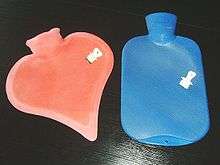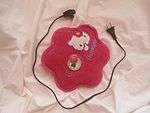Hot water bottle


A hot water bottle (or hottie[1]) is a container filled with hot water and sealed with a stopper, used to provide warmth, typically while in bed, but also for the application of heat to a specific part of the body.
Early history
Containers for warmth in bed were in use as early as the 16th century. The earliest versions contained hot coals from the dying embers of the fire, and these bed warmers were used to warm the bed before getting into it.
Containers using hot water were soon also used, with the advantage that they could remain in the bed with the sleeper.
Prior to the invention of rubber that could withstand sufficient heat, these early hot water bottles were made of a variety of materials, such as zinc, copper, glass, earthenware or wood. To prevent burning, the metal hot water flasks were wrapped in a soft cloth bag.
Rubber bottles

"India rubber" hot water bottles were in use in Britain at least by 1875.[2] Modern conventional hot water bottles were patented in 1903 and are manufactured in natural rubber or PVC, to a design patented by the Croatian inventor Eduard Penkala. They are now commonly covered in fabric, sometimes with a novelty design.
By the late 20th century, the use of hot water bottles had markedly declined around most of the world. Not only were homes better heated, but newer items such as electric blankets were competing with hot water bottles as a source of night-time heat. However the hot water bottle remains a popular alternative in Australia,[3] Ireland, United Kingdom, developing countries and rural areas. For example, it is widely used in Chile, where it is called a "guatero".[4] There has been a recent surge in popularity in Japan where it is seen as an ecologically friendly and thrifty way to keep warm.[1]
Some newer products function like the older bottles, but use a polymer gel or wax in a heat pad. The pads can be heated in a microwave oven, and they are marketed as safer than liquid-filled bottles or electrically-heated devices. Some newer bottles now use a silicone-based material instead of rubber, which resists very hot water better, and does not deteriorate as much as rubber. Although the stopper size in Ireland and the UK has been largely standard for many decades, the newer bottles (notably those from German manufacturer Fashy) use a wider mouth which is easier to fill (and a larger stopper to fit it).
While generally used for keeping warm, conventional hot water bottles can be used to some effect for the local application of heat as a medical treatment, for example for pain relief,[5] but here also, newer items such as purpose-designed heating pads are now often used.
Regulation
Hot water bottles are meant to contain very hot fluids and also supposed to be in contact with human skin. This is therefore of utmost importance to ensure, mainly through standards and regulations, that the closing and welding is stable enough to prevent burns, but also to make sure that the bottle’s chemical components are not dangerous for human health. More generally, it is crucial to certify and assure that hot water bottles, whether manufactured, sold or imported are safe.
For instance, the United Kingdom defined British Standards for hot water bottles to regulate their manufacture and sale as well as to ensure their compliance with all safety standards. The British Standards BS 1970 and BS 1970:2012 (updated version) define, for instance, the bottles’ filling characteristics, safety instructions, allowed materials and components as well as testing methods such as tensile tests for PVC bottles.
Most regulations applied to a country are generally harmonized in order to be applied and applicable in a larger area, such as a trade zone.
Problems
There have been problems with premature failure of rubber hot water bottles due to faulty manufacture.[6] The rubber may fail strength or fitness tests, or become brittle if manufacturing is not controlled closely. Natural rubber filled with calcium carbonate is the most common material used, but is susceptible to oxidation and polymer degradation at the high temperatures used in shaping the product. Even though the brittle cracks may not be visible externally, the bottle can fracture suddenly after filling with hot water, and can scald the user—sometimes requiring hospitalization for severe burn cases.[7][8]
Boiling water is not recommended for use in hot water bottles. This is due to risks of the rubber being degraded from high-temperature water, and the risk of injury in case of breakage.
See also
| Wikimedia Commons has media related to Hot-water bottles. |
References
- 1 2 Lewis, Leo (November 29, 2008). "Japan's thrifty find the hot water bottle to survive the chill". The Times.
- ↑ Teale, John W. (10 July 1875). "Mr. Teale's Case Of Excessively High Temperature". The British Medical Journal. 2 (758): 57. doi:10.1136/bmj.2.758.57.
- ↑ Collier, Karen (16 August 2012). "Households stock up on hot water bottles to keep warm and save on power bills this winter". News Corp. Archived from the original on 24 July 2015.
- ↑ "guatero"
- ↑ Jha, Alok (5 July 2006). "Heat 'relieves internal pain'". The Guardian. Archived from the original on 25 September 2014.
- ↑ "Hot water bottles recalled over leak danger". The Sydney Morning Herald. Fairfax Media. AAP. 2 September 2009. Archived from the original on 24 July 2015.
- ↑ Miletic, Daniella (22 July 2009). "Shoddy hotties in hot water". The Sydney Morning Herald. Fairfax Media. Archived from the original on 24 July 2015.
- ↑ "ACCC launches hot water bottle blitz". The Sydney Morning Herald. Fairfax Media. AAP. 21 July 2009. Archived from the original on 24 July 2015.